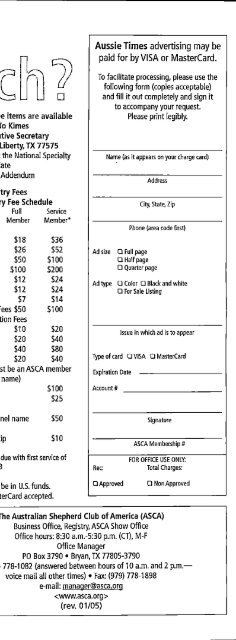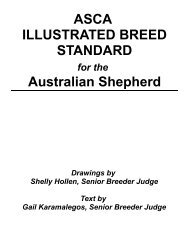Create successful ePaper yourself
Turn your PDF publications into a flip-book with our unique Google optimized e-Paper software.
their individual contributions to the overall<br />
trait. It would be very shortsighted ofus to<br />
assume that a very few dominant genes are<br />
involved simply because it gives us the out<br />
ofdeclaring that the unwanted result is the<br />
fault not ofones own dog, but ofthe one it<br />
was bred to. And since these traits usually<br />
arise in the offspring of normal parents,<br />
how on earth can we know which one of<br />
them gave what?<br />
There is hope that someday science<br />
will come up with a way to determine<br />
genotype on polygenetic traits. Early<br />
research into canine genetic disease<br />
focused on single-gene inheritance. These<br />
traits were the easiest to track. Now that<br />
scientists can pick apart the very structure<br />
of the dog's DNA, they are beginning to<br />
identify polygenetic traits as well.<br />
One of these is epilepsy in Belgian<br />
Sheepdogs and Tervurens. Researchers<br />
have discovered that in these closely related<br />
breeds, there is one gene with major impact<br />
and others that contribute to its expression.<br />
Efforts are underway to develop a screening<br />
test for that key gene. Controlling it may<br />
drastically reduce if not eliminate epilepsy<br />
in those breeds.<br />
Until genetic tests<br />
become available,<br />
breeders need to<br />
amass as much<br />
information as<br />
possible about<br />
both positive and<br />
negative traits.<br />
Once genetic tests are developed, we<br />
can work toward eliminating them even<br />
though we may not totally remove all<br />
the BINGO alleles from the breed. With<br />
a screening test, if you know the dog as<br />
B and G and the bitch has only I, you are<br />
safe to breed. But if the bitch has N and<br />
O as well as I, she isn't a good match for<br />
your dog. Even if you know the genotypes<br />
of the parents, you won't know how the<br />
BINGO alleles fell in the pups, so you<br />
would then screen any that were to be bred<br />
so the results could be compared with those<br />
for prospective mates. This way you will<br />
Q &A<br />
be able to avoid crosses that produce the<br />
disease. The point is not to totally eradicate<br />
all BINGO alleles, but to produce healthy<br />
pups. With screening tests, we will even be<br />
able to view genes for very serious diseases<br />
as a sort of fault rather than an automatic<br />
reason to take an animal out ofthe breeding<br />
pool.<br />
Lacking any kind of screening test,<br />
the best breeders can do is evaluate risk<br />
and try to lower it via careful mating<br />
choices. That may mean never breeding<br />
an otherwise excellent individual because<br />
the risk is too high. Risk analysis will not<br />
totally prevent unwanted traits, but it is the<br />
best tool available at present. However, it<br />
is dependent on the open exchange of<br />
information between breeders about what<br />
dogs have had or produced disease.<br />
Until genetic tests become available,<br />
breeders need to amass as much information<br />
as possible about both positive and negative<br />
traits. Not only in their own dogs, but<br />
their relatives, too. Careful study of<br />
pedigrees, including the vertical pedigrees<br />
which include siblings of the dog and its<br />
progenitors, noting which dogs had or<br />
produced a trait, how many of them there<br />
are in the pedigree and how close they are<br />
to the subject dog will provide the breeder<br />
with an idea of how likely a particular dog<br />
is to have or throw the trait.<br />
With careful record keeping, diligent<br />
study of pedigrees, and—as they become<br />
available—genetic screening tests, a<br />
breeder can make progress toward desirable<br />
polygenetic traits and away from the<br />
undesirable. With a high level of honesty<br />
and cooperation between breeders, progress<br />
will come even faster. Some day nobody<br />
will have to yell "BINGO!" because of a<br />
bad line of beans.<br />
The author would like to acknowledge Michele<br />
Betitfor suggesting the BINGO concept on the<br />
EpiOenes discussion list.<br />
ASCA <strong>2005</strong><br />
Election Calendar<br />
March<br />
Director Candidate resumes due to<br />
the ASCA Business Office<br />
on or before 5:00 p.m. on the 1st<br />
Tuesday in March.<br />
March 10<br />
All Director Candidates resumes<br />
from the ASCA Business Office<br />
are due to the Aussie Times<br />
editorfor publication<br />
in the May/June Issue ofthe<br />
Aussie Times.<br />
May 1 (or first business day<br />
thereafter)<br />
Mailing of all Foreign ballots.<br />
May 15 (or first business day<br />
thereafter)<br />
Mailing of all ballots to U.S.<br />
members. If a ballot hasn't been<br />
received by June 1, member(s)<br />
should contact the<br />
ASCA Business Office.<br />
<strong>July</strong> 15<br />
All completed ballots are due<br />
in the hands of the receiver<br />
(not postmarked) on or before<br />
this date.<br />
<strong>July</strong> 20<br />
On or before this date, all Director<br />
Candidates to be notified of<br />
election results. Official notice<br />
ofvoting results will be given to<br />
the membership at the General<br />
Membership Meeting at the ASCA<br />
National Specialty.<br />
80 AUSSIE TIMES I <strong>July</strong>-<strong>Aug</strong>ust <strong>2005</strong>



